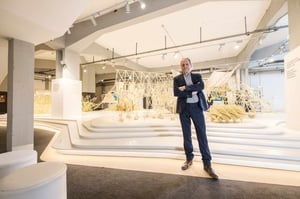“Without imagination we wouldn’t be alive: the task of an artist is to stimulate peoples’ imagination”.
This statement made by Theo Jansen on the inauguration day of the “Dream Beasts” exhibition at the National Science and Technology Museum of Milan encompasses the entire poetic vision of the artist. Transfixed, as he himself says, at the age of 10 by the extraordinary futuristic projects of Leonardo da Vinci, Jansen maintained the imagination and inventive spirit he had as a boy intact, expressing them through his remarkable scientific knowledge (he is an academically-trained physicist).
The result is a revolutionary process that unites art and science in an original mix of evolutionary logic and engineering design, to create “live and truly unpredictable creatures”. Jansen’s imaginary and extraordinary creatures manage, by some miracle, to be a mechanical work of art and an extraordinarily successful example of Arte Povera: he builds his “Strandbeests” (beach animals) by connecting thin yellow PVC tubes, using adhesive tape, rubber bands and zip ties.
The artist explains:
“Plastic tubes are a very common and widely-used material in Holland. We humans are based on a single substance: protein. The reeds, the tubes, are my protein, the base I use to bring my creations to life. With this material you have to make an effort to search and search again for the right solution, because nothing is ready-made. The final result is always unpredictable”.
The origin of the sculptures is explained in great detail in a TED Conference in 2007, when Jansen’s kinetic creations were already far advanced (his first project dates back to 1990) and were experiencing some technical problems that had to be resolved.
Jansen’s mechanical “animals do not get their energy from food, but from the wind. And it is the wind that makes the feathers on their backs move, directing their feet. And the “wings” pump air into the plastic bottles, which are on top, and are capable of holding it as if they were internal organs, to then use that energy and power the movement, if the wind were to stop blowing.
But how do these creatures, that do not use engines, move? To design and regulate the “legs” system, the artist wrote a special computer programme. And he had to…reinvent the wheel.
“So, the proportion of the tubes in this animal is very important for the walking. There are 11 numbers, which I call The 11 Holy Numbers. These are the distances of the tubes which make it walk that way. In fact, it’s a new invention of the wheel. It works the same as a wheel. The axis of a wheel stays on the same level, and this hip is staying on the same level as well. In fact, this is better than a wheel, because when you try to drive your bicycle on the beach, you will notice it’s very hard to do. And the feet just step over the sand, and the wheel has to touch every piece of the ground in-between. So 5,000 years after the invention of the wheel, we have a new wheel”.
Basically, the irresistible charm of Jansen’s kinetic marvels lies in their ability to revisit the entire evolutionary history of our planet: his animals look like gigantic insects or prehistoric skeletons. And his inventions, in the era of robots and Artificial Intelligence, evoke the memory of the “prodigal machines” that fascinated our forefathers in ancient times.

